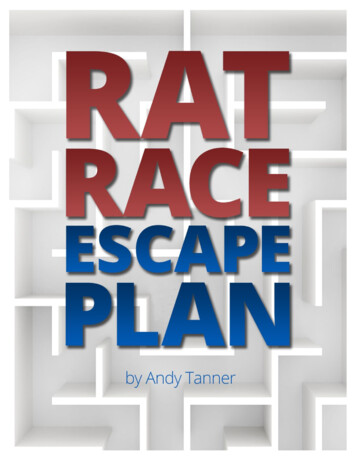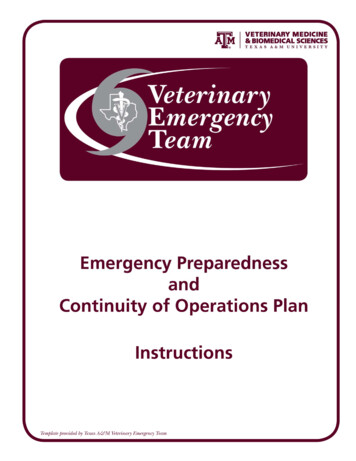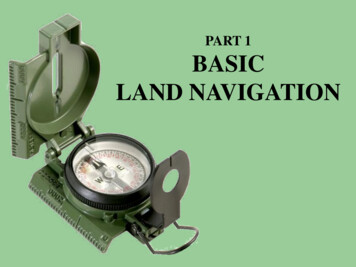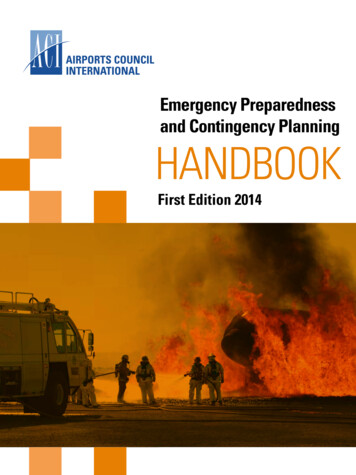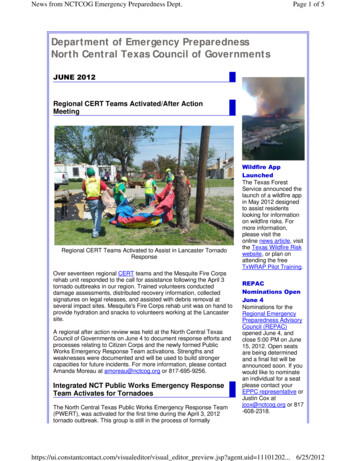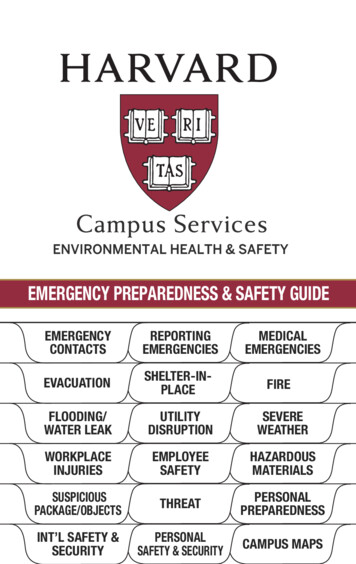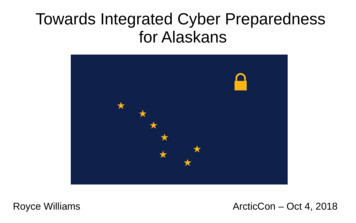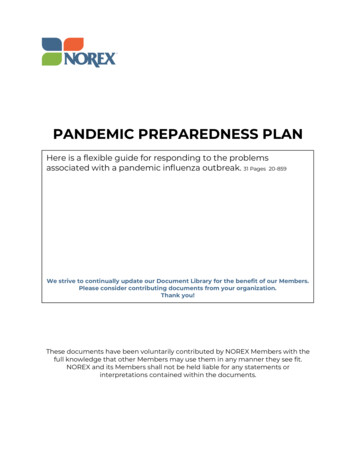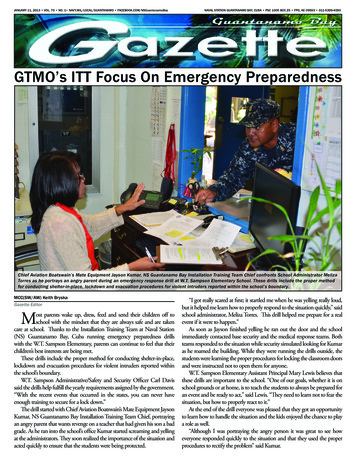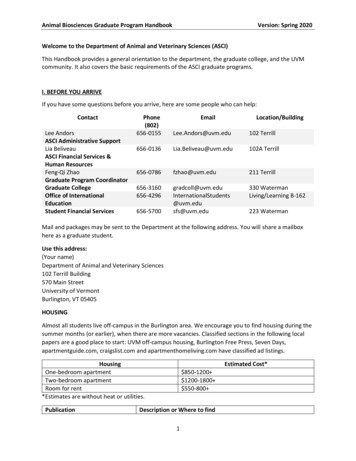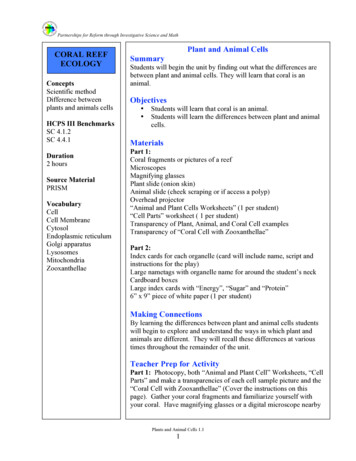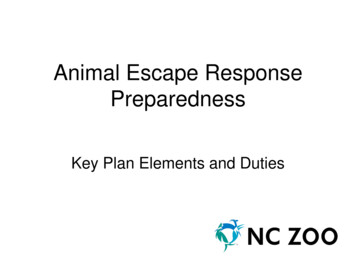
Transcription
Animal Escape ResponsePreparednessKey Plan Elements and Duties
Ken ReiningerGeneral Curator of Animal CollectionsNorth Carolina ZooKen.Reininger@nczoo.org
Elements of North Carolina Zoo’sResponse Plan Comprehensive Written Response PlanNational Incident Command StructureCentralized Communications HubWeapons TeamClearly defined responsibilities for all staffSite Evacuation PlanInterface with local authoritiesStaff TrainingDrills
Written Response Plan Purpose & goals; associated equipment & documentsGuidelines for reporting an escapeKey authority roles (IC, Ops Chief, Ops Supervisor, etc)Detailed responsibilities for all staff (arranged in logical units)Tracking & documenting key response elementsClearly stated criteria for authorizing weapons dischargeCritical perimeter securityLists of dangerous and deadly speciesKey staff contact numbersProcedures for animals that have left the siteProcedures for after hours
Recommended Standard Document FormatDocument Name:Document Number:Prepared By:Approved By:Signature:Date:NC Zoo Animal Section1.0 Purpose:2.0 Associated Equipment:3.0 Associated Documents:4.0 Trainer:5.0 Evaluator:6.0 SOP Controlled Document Location:7.0 Procedure:Revision Number: 0Revision Dates:Created Date:Effective Date:Reviewed Date:Review Frequency: every x yrsNext Review Due:Page 1 of
Goals & Objectives Of "Escaped Animal Recapture Procedure" is toestablish responsibilities, roles, procedures andguidelines for Zoo personnel to follow during animalescapes. Of "Animal Escape Preparedness Plan" (separatedocuments) is to develop best practices, tools, trainingand drills to prepare staff so they may safely implementall aspects of a recapture plan should an escape occur.Drills of this procedure will be conducted at least twiceper year. A maximum of one actual escape response peryear (if they occur) can be counted as a drill. "Table top"discussions by Animal Section Curators and AnimalManagement Supervisors may supplement drills.
Associated Equipment &Documents Associated Equipment: zoo vehicles, shotguns, .375rifles, recapture equipment (nets, etc) Associated Documents: NCZ Emergency ResponsePlan; NCZ Park Evacuation Plan; NCZ CrisisCommunications Plan; NCZ Weapons TeamManagement Policy & Guidelines; NCZ Escaped AnimalResponse Preparedness Plan
Reporting An EscapeThe employee reporting the escape should remain calm, speak deliberatelyand clearly and provide the following information to the best of theirknowledge:– Name of reporting employee– If reporting via telephone give the location and phone extension number you arereporting from so you can be located/contacted again as needed.– The species of escaped animal. (if the exact species is not known use closestgroup term for example bear, large cat, antelope, etc.)– The number of escaped animals observed– Exact location of animal(s)– Direction of animal(s) movement– Condition and behavior of animal (injured, panicked, running, etc)– Any humans injured by the escaped animal– Animal description (sex, adult/young, specific ID) if knownNote: Stickers which contain this list of critical types of information and canbe affixed to hand held radios.
Key Response Authorities Incident CommanderOperations ChiefOperations SupervisorCommunications CoordinatorFollows National Incident Management Systemstandards and terminology
Incident Commander – has overall responsibility for theentire response to the incident or eventOperations Chief – oversees tactical operations planning tocarry out parts of the responseOperations Supervisors – oversee implementation of theplanCommunications Coordinator – insures all staff receive vitalinformation; tracks completion of critical response elements
Key Duties of Incident Commander Establish a command post Notify key non-animal staff (zoo senior staff,public relations staff, etc) Coordinate process to account for all zoo staff Determine if all or partial park evacuation isneeded Look after needs of injured, including friends orrelatives of injured Coordinate with responding outside agencies
Key Duties for the Operations Chief Insure all staff are aware of incident & detailsMobilize weapons teamMobilize vet staffMobilize and assign responding zookeeper staffTrack perimeter gate securityDetermine if other enclosure mates are secureDetermine if area staff is accounted for and safeEstablish a rendezvous location for key responding staffEstablish a perimeterDevelop a recapture planManage the weapons teamKeep IC informed of recapture status, injuries, etcLead post event review meeting
Key Duties of Zookeepers Secure animal areas and prepare to mobilizeMuster recapture and personal protection equipmentAttend to gate security assignmentsGet visitors nearby into safe areasMonitor escape details and respond to pre-designatedlocations or instruction from OC Prepare to participate in setting perimeters and searchefforts If not needed for animal recapture, be available forcrowd control or assignment by IC
Communications Coordinator ChecklistZOOCOM Checklist for Tracking & Prompting Critical Information During an Animal EscapeResponseUse Emergency Tone and Repeat broadcast information confirming that this is not a drill:AN ANIMAL ESCAPE IS IN PROGRESS - ALL UNITS SWITCH TO CHANNEL 1Record : (prompt if needed to get information very early on in the event)[ ] - Time of initial call:Person reporting escape:[ ] -Species/Type of animal :[ ] -Number of animals :[ ] - Last Reported Location :[ ] -Direction of movement :[ ] -Status of any human injuries :Determine (if possible):[ ] -Animal's behavior (calm, agitated, aggressive, etc.) :[ ]- Is animal injured : [ ] Yes [ ] No[ ]-Cause or route of escape:Use Emergency Tone then Simulcast on channels 1, 2, and 6:–––Animal escape in progress, THIS IS NOT A DRILLBroadcast all available information from aboveRepeat all critical information at least every 5 minutes(See complete form in NCZ Escaped Animal Response Procedure document provided)
Other Responsibilities(list in separate sections of the procedure document) Vet staffZoo security staffZoo office staffAll non- animal care staffContractors working on siteZoo Society staffetc
Other Plan Elements List of perimeter gates with gate securityresponsibilities Park map List of dangerous and deadly animal species inthe collection (may have different levels of responsewith regard to elements like mobilizing weapons) List of emergency contact numbers for key staff Procedures for escapes after hours Procedures if escaped animal breaches zooperimeter fence
Related Types of Events(requires similar but not identical response, therefore separate writtenprocedures, drills, etc) Person in a dangerous animal exhibitAnimal escape within a holding buildingElephant escape or man-down situationVenomous reptile biteDive accidentMultiple simultaneous emergencies
Weapons Team Management Identify team members (need enough to always havetwo on duty at any time) Basic safety and marksmanship training with local lawenforcement Weapons selection and maintenance Clearly defined eligibility and qualification requirements Range qualification at least twice per year Clearly defined weapons discharge criteria Identified program leader Range leader qualifications and training
Drills Should be conducted at least twice annually Should be rotated regarding species & involvedstaff to cover various scenarios, roles, etc. Should be well planned in advance with specificgoals and objectives Should be followed by response review meetingand well documented May want to start with announced drills thenmove to unannounced Ability to conduct drills with visitors in the park?
Reference Documents Provided North Carolina Zoo Escaped Animal EmergencyResponse Plan NCZ Animal Escape Response Preparedness Plan NCZ Weapons Team Management Policies &Procedures NCZ Person in a Dangerous Animal Exhibit EmergencyResponse Procedure NCZ Venomous Reptile Bite Emergency ResponseProcedure
Policy vs Procedure vs GuidelineThere are legal differences between these 3 termsPolicy: un-ambiguous, officially approved and written rule or directive failure to follow has serious consequences up to and includingdismissal if not followed as writtenProcedure: officially approved fixed step by step course or series of actions, withdefinite start and end, that must be performed completely and in aregular, definite order but with some latitude for judgmentGuideline: recommended methods for performing tasks that allow somediscretion or leeway in their interpretation, implementation, or use
Audience Discussion & Questions Examples of procedures at other zoos fromconference delegates – similarities & differences Questions about specific response elements Problems and problem solving discussion Differences for person in an exhibit, venomousbites, elephant emergencies, escapes withinholding, etc Examples of real escapes and responses fromconference delegates
Document Name:NCZ Escaped Animal Emergency Response ProcedureDocument Number: AS - 1Prepared By: John D. GrovesApproved By: Ken Reininger, General CuratorSignature:NC Zoo Animal SectionDate:Revision Number: 8Revision Dates: Jan 2013; July, 2011; June,2010; April 2010; Jan 2009; Nov 2007; Feb,2005; Nov 2004Created Date: April 1994Effective Date: April 1994Reviewed Date: 20 July, 2011Review Frequency: every 2 yrsNext Review Due: January 2015Page 1 of 26Wording in red type represents changes made Nov, 2011 after drill on 20 Oct, 2011 and in March 2012 afterElephant/Rhino escape response review meeting, also in Dec, 2012 after the Rhino escape and in Jan 2013based on feedback from Chief Zoo Ranger Mike HoneycuttNORTH CAROLINAZOOLOGICAL PARKEscaped Animal Emergency ResponseProcedure
TABLE OF CONTENTSINTRODUCTION. 1REPORTING AN ANIMAL ESCAPE . 2REPORTING NON-DANGEROUS ANIMAL ESCAPES . 2RESPONSE PROCEDURE AUTHORITY . 3INCIDENT COMMANDER. 3OPERATIONS CHIEF (CAPTURE COORDINATOR) . 3ZOOCOM . 3OPERATIONS SUPERVISOR. 3RESPONSIBILITIES OF THE INCIDENT COMMANDER . 4RESPONSIBILITIES OF THE OPERATIONS CHIEF (CAPTURE COORDINATOR) . 5RESPONSIBILITIES OF ZOO COM . 6ZOOCOM Checklist. 7RESPONSIBILITIES OF WEAPONS TEAM MEMBERS . 9SUSPENSION OF FIREARMS DISCHARGE AUTHORIZATION. 9RESPONSIBILITIES OF VETERINARY PERSONNEL . 10RESPONSIBILITIES OF ANIMAL SECTION PERSONNEL . 11GATE SECURITY . 12RESPONSIBILITIES OF PARK RANGERS . 14COMMUNICATIONS: . 14CROWD CONTROL: . 14TRAFFIC CONTROL: . 14RESPONSIBILITIES OF CURATORS' OFFICE STAFF . 15OFFICE ASSISTANT IV & ZOO REGISTRAR . 15RESPONSIBILITIES OF ALL ZOO PERSONNEL . 16SAFEST LOCATIONS ON ZOO GROUNDS DURING AN ANIMAL ESCAPE: . 16CROWD CONTROL. 17EVACUATION OF THE ZOO . 17ANIMAL ESCAPES AFTER HOURS . 18ANIMAL OFF ZOO GROUNDS . 19PROCEDURE UPDATES & REVISIONS . 19APPENDIX I: LIST OF DANGEROUS ANIMALS. 20APPENDIX II: SENIOR ANIMAL SECTION STAFF . 21APPENDIX III: ANIMAL SECTION AFTER HOURS EMERGENCY CONTACT LIST . 22APPENDIX IV: IMPORTANT GATES DURING ANIMAL ESCAPES . 23July 2011ii
INTRODUCTION1.0 Purpose: It is fundamental to the public exhibition of an exotic animal collection to design enclosures andsystems for holding, shifting and transporting animals that safely contain them. However, no matter howwell the enclosures are designed and procedures are adhered to, the possibility of an animal escape is everpresent. Therefore, a comprehensive plan must exist that outlines procedures to guide the quick and saferecapture of escaped animals and protects zoo visitors, employees and neighbors from harm. Recaptureprocedures should also be part of a larger plan that includes preparedness plans and training to improveresponding staff's ability to function under emergency conditions and routine facilities and practices reviewsthat help prevent similar situations from occurring.Goals: The objective of the "Escaped Animal Recapture Procedure" is to establish responsibilities, roles,procedures and guidelines for Zoo personnel to follow during animal escapes.The objective of the "Animal Escape Preparedness Plan" (separate document) is to develop best practices,tools, training and drills to prepare staff so they may safely implement all aspects of a recapture plan shouldan escape occur. Drills of this procedure will be conducted at least twice per year. A maximum of one actualescape response per year (if they occur) can be counted as a drill. "Table top" discussions by Animal SectionCurators and Animal Management Supervisors may supplement drills.2.0 Associated Equipment: zoo vehicles, shotguns, .375 rifles, recapture equipment (nets, etc)3.0 Associated Documents: NCZ Emergency Response Plan, NCZ Park Evacuation Plan, NCZ CrisisCommunications Plan, NCZ Weapons Team Management Policy & Guidelines, NCZ Escaped AnimalResponse Preparedness PlanDefinitions Animal Escape: any event when a zoo collection animal is no longer securely enclosed by the primarycontainment barriers for its exhibit or holding facility. Zoo personnel: all permanent and temporary/seasonal paid staff of the North Carolina Zoo, employees ofthe North Carolina Zoological Society, Sodexo food and catering services employees, certified zoovolunteers, Zoo School staff and students, Davidson Community College Zoo Technology Programinterns, registered research students and interns, and any approved contractor staff on site. Dangerous Animals: all animals included in the list in Appendix 1 of this document. There are threelevels of danger reflected in the list. All animals on all levels are considered dangerous. Primary containment: the main and first level barrier designed to contain an animal under normalhousing. This may be the only containment barrier however in other cases additional outer layers ofcontainment may exist (such as for enclosures located inside buildings). While more than one layer ofcontainment barrier may exist, the primary containment barrier is typically the only one designed to berelied upon. Once the primary containment barrier is breached the animal has escaped. Secondary Containment: containment layers outside the primary containment barrier Full Response: Responses including mobilization of the Weapons Team, Veterinary staff, much ofAnimal Section staff, all Ranger staff and including ZooCom coordination and the suspension of somepark operations such as admissions and in-park transport. Response Operations Area: the area in the immediate and close vicinity of the animal escape4.0 Trainer: Heads, Managers and Supervisors for all zoo Sections5.0 Evaluator: General Curator of Animals6.0 Staff Access to Procedure: Original in Animal Curators’ Office; electronic access on Animal SectionInfowebJuly 20111
7.0 Procedures:REPORTING AN ANIMAL ESCAPEEach and every animal escape, regardless of relative danger posed by the animal, is to be reported. Dangerousanimal escapes must be reported immediately to ZooCom, by hand-held radio whenever possible or by phone(ext 7542) if not possible via radio. (see list of Dangerous Animals in NC Zoo collection Appendix I).The employee reporting the escape should remain calm, speak deliberately and clearly and provide the followinginformation to the best of their knowledge:1. Name of reporting employee2. If reporting via telephone give the location and phone extension number you are reporting from so youcan be located/contacted again as needed.3. The species of
Wording in red type represents changes made Nov, 2011 after drill on 20 Oct, 2011 and in March 2012 after Elephant/Rhino escape response review meeting, also in Dec, 2012 after the Rhino escape and in Jan 2013 based on feedback from Chief Zoo Ranger Mike Honeycutt
